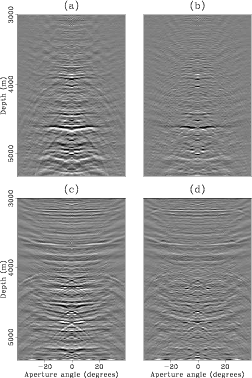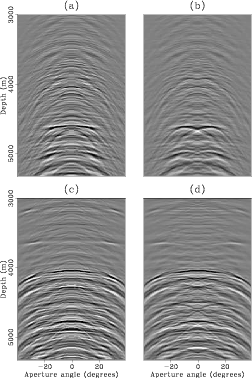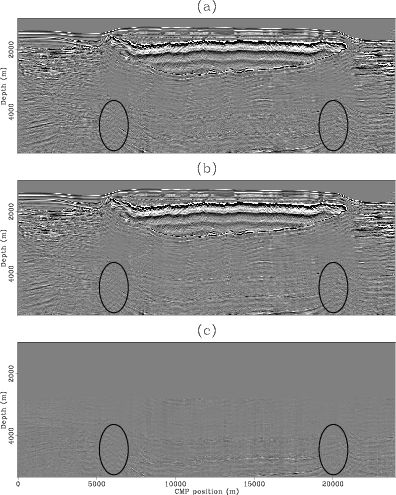|
|
|
|
Rather than suppressing the multiples in the model domain, I chose to suppress the primaries and inverse transform the multiples to ADCIGs. This is more convenient because the primaries are not ``filtered'' through the imperfect forward-inverse Radon transform pair. The primaries were then recovered by directly subtracting the multiples from the data. I did not apply adaptive subtraction to obtain the results presented in this chapter. This is such an important issue that I designed a new algorithm for it and will present it in the next chapter. Figure 18 shows a close-up comparison of the primaries extracted with the standard 2D Radon transform (Sava and Guitton, 2003) and with the apex-shifted Radon transform for the two ADCIGs at the top in Figure 15. The standard transform (Figures 18a and 18c) was effective in attenuating the specular multiples, but failed at attenuating the diffracted multiples (below 4000 m), which are left as residual multiple energy in the primary data. Again, this is a consequence of the apex shift of these multiples. There appears not to be any subsalt primary reflections in Figures 18a and 18(b). The flattish reflector at about 4600 m in panel (b) is actually residual multiple energy (compare with panel (a)). Similarly for Figures 18(c) and 18(d). Figure 19 shows a similar comparison for the extracted multiples. Notice how the diffracted multiples were correctly identified and extracted by the apex-shifted Radon transform, in Figures 19(b) and 19(d). In contrast, the standard 2D transform misrepresent the diffracted multiples as though they are specular multiples as seen in Figures 19(a) and 19(c).

|
|---|
|
comp-prim1
Figure 18. Comparison of primaries extracted with the 2D Radon transform (a) and (c) and with the apex-shifted Radon transform (b) and (d). Notice that some of the diffracted multiples remain in the result with the 2D transform. |
|
|

|
|---|
|
comp-mult1
Figure 19. Comparison of multiples extracted with the 2D Radon transform (a) and (c) and with the apex-shifted Radon transform (b) and (d). |
|
|

|
|---|
|
comp-prim1-stack
Figure 20. Comparison of angle stacks for primaries. Panel (a) corresponds to the primaries obtained with the standard Radon transform. Panel (b) corresponds to the primaries obtained with the apex-shifted Radon transform and panel (c) is the difference between panels (a) and (b). The ovals correspond to the diffracted multiples. |
|
|

|
|---|
|
comp-mult1-stack
Figure 21. Comparison of angle stacks for multiples. Panel (a) corresponds to the multiple model computed with the standard Radon transform. Panel (b) corresponds to the multiple model computed with the apex-shifted Radon transform. Notice the difference in the attenuation of the diffracted multiples. The ovals correspond to the diffracted multiples. |
|
|
|
|
|
|